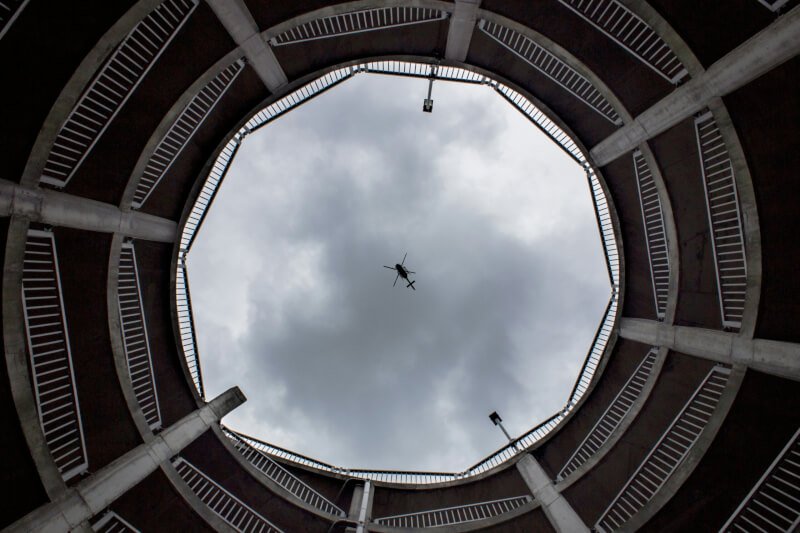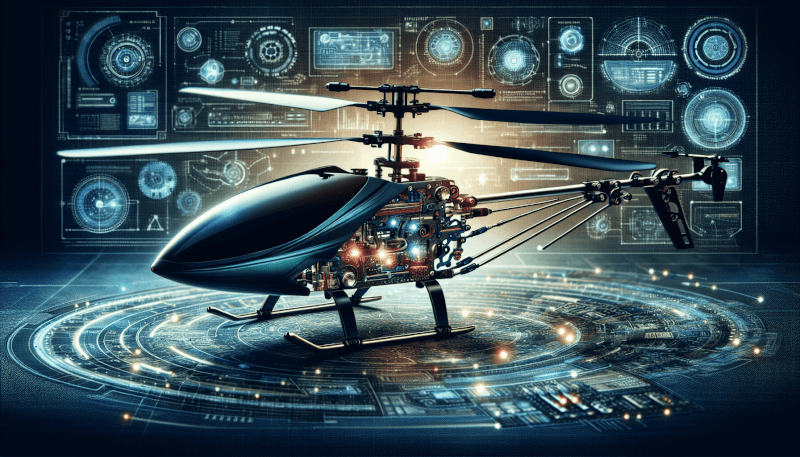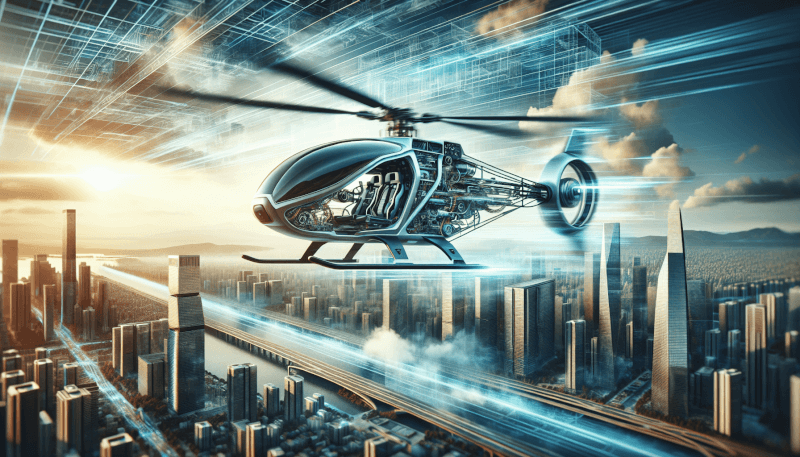In this exciting article, you will discover the top 5 innovations and advancements in technology that have revolutionized the world of remote control helicopters. From enhanced stability systems to cutting-edge materials, these developments have taken RC heli enthusiasts to new heights of excitement and performance. Whether you’re a seasoned pilot or just getting started, this article will surely leave you inspired and eager to take your flying skills to the next level. So buckle up, because we’re about to embark on an exhilarating journey into the world of RC heli technology!
1. Brushless Motors
Components of a Brushless Motor
Brushless motors are a key component in RC helicopters, providing efficient and reliable power for the rotors. Unlike traditional brushed motors, brushless motors do not have permanent magnets on the rotor and incorporate electronic controllers to manage the motor’s operation. The main components of a brushless motor include the stator, rotor, windings, and electronic speed controller (ESC). The stator consists of multiple windings, which produce a magnetic field when connected to a power source. The rotor, on the other hand, contains permanent magnets that create a rotating magnetic field. The ESC regulates the power flow to the windings based on feedback from sensors, ensuring smooth and precise motor control.
Advantages of Brushless Motors
Brushless motors offer several advantages over their brushed counterparts. Firstly, they are more efficient, generating less heat and consuming less energy. This increased efficiency allows for longer flight times and better overall performance. Additionally, brushless motors have a longer lifespan due to reduced wear and tear on the motor components. The absence of brushes also eliminates the need for regular maintenance and brush replacement. With brushless motors, RC helicopter enthusiasts can enjoy a reliable and hassle-free flying experience.
Applications in RC Helis
Brushless motors have revolutionized the world of RC helicopters, enabling advanced flight capabilities and thrilling aerobatics. The superior power-to-weight ratio of brushless motors allows for higher speed and greater maneuverability. These motors have found widespread use in both beginner-friendly and professional-grade RC helicopters. From small-scale indoor models to large outdoor helicopters, brushless motors provide the necessary power and performance for a wide range of applications. Whether you are a casual hobbyist or a competitive flyer, brushless motors are an essential component for taking your RC heli adventures to new heights.
2. Flybarless Systems
Introduction to Flybarless Systems
Flybarless systems are an innovative technology that has significantly impacted the RC helicopter industry. Traditionally, helicopters used a flybar, a rotating mechanical device, to stabilize the rotor system. However, flybarless systems replace the flybar with electronic sensors that measure the helicopter’s attitude and movement. These sensors send real-time data to the flight controller, which adjusts the rotor’s pitch and speed accordingly, resulting in precise control and stability. This advancement in technology has brought about a new era of responsiveness and maneuverability in RC helicopters.
Benefits of Flybarless Systems
The benefits of flybarless systems are numerous. Firstly, they offer improved stability by eliminating the complexities and potential mechanical limitations of a flybar setup. This enhanced stability translates to better control during flight, making flybarless systems ideal for both beginners and experienced pilots. Furthermore, flybarless systems enable faster and more agile maneuvers, allowing for a wider range of aerobatic tricks and stunts. The reduced mechanical complexity of flybarless systems also contributes to easier maintenance and setup, making them an attractive option for RC helicopter enthusiasts.
How Flybarless Systems Work
Flybarless systems rely on electronic sensors, often gyroscopes and accelerometers, to monitor the helicopter’s movement. These sensors detect changes in pitch, roll, and yaw and send this information to the flight controller. Using algorithms and calculations, the flight controller adjusts the rotor’s cyclic and collective pitch to maintain stability and control. The flybarless system continuously analyzes and adjusts the rotor’s movements, providing an unparalleled level of precision and responsiveness. By eliminating the mechanical components of a flybar, flybarless systems offer a more direct control mechanism, resulting in smoother and more precise flight characteristics.

3. Self-stabilization Technology
Understanding Self-stabilization Technology
Self-stabilization technology is a game-changer in the world of RC helicopters, particularly for beginners or those seeking a more relaxed flying experience. This technology utilizes sophisticated algorithms and sensors to automatically stabilize the helicopter during flight. Self-stabilization systems constantly monitor the helicopter’s orientation and attitude and make subtle adjustments to maintain a level and stable flight. By providing a helping hand in maintaining control, self-stabilization technology reduces the learning curve and increases the enjoyment of flying an RC helicopter.
Features of Self-stabilization Systems
Self-stabilization systems offer various features designed to enhance stability and control. One common feature is the automatic level-flight mode, where the helicopter maintains a horizontal position even if the controls are released. This mode is especially useful for beginners or when flying in challenging conditions. Additionally, self-stabilization systems often include altitude hold capabilities, allowing the helicopter to hover at a specific height without constant user input. These features give pilots greater confidence, allowing them to focus on other aspects of flying, such as maneuvering or capturing aerial footage.
Improvements in Stability and Control
Self-stabilization technology has significantly improved the stability and control of RC helicopters. By providing automatic corrections, it minimizes the effects of external factors such as wind gusts and turbulence. This enhanced stability allows for smoother and more precisely controlled flights, even in less-than-ideal conditions. Moreover, self-stabilization systems enable pilots to perform maneuvers that would otherwise require advanced flying skills. With the assistance of this technology, beginners can enjoy stable and predictable flights, while experienced pilots can push the boundaries of their aerobatic abilities.
4. Advanced Gyroscopes
Role of Gyroscopes in RC Helis
Gyroscopes play a crucial role in the stability and control of RC helicopters. These devices measure the angular velocity of the helicopter around its various axes and provide feedback to the flight controller. By detecting and compensating for tilting and rotation, gyroscopes help maintain a level flight and prevent unwanted movement. In traditional RC helicopters, gyroscopes were used to stabilize the flybar system. However, with the advent of flybarless systems, gyroscopes now directly contribute to stabilizing the rotor system, resulting in more precise and responsive flight characteristics.
Enhancements in Gyroscope Technology
Over the years, advancements in gyroscope technology have greatly improved the performance of RC helicopters. Modern gyroscopes are highly sensitive and capable of detecting even the slightest changes in the helicopter’s orientation. They offer adjustable sensitivity settings, allowing pilots to fine-tune the response of their helicopter to match their flying style and conditions. In addition, gyroscopes now incorporate advanced algorithms that can actively counteract aerodynamic disturbances and external forces. These enhancements make gyroscopes an essential component for achieving stable flight and precise maneuvering.
Effects on Stability and Maneuverability
The use of advanced gyroscopes has had a profound impact on the stability and maneuverability of RC helicopters. By detecting and correcting deviations from the desired flight path, gyroscopes contribute to a more stable and controlled flight experience. They greatly reduce the effects of external factors, such as gusts of wind or rapid changes in throttle, allowing pilots to maintain their intended flight trajectory. This increased stability opens up new possibilities for aerobatics and complex maneuvers, as pilots can confidently push the limits of their RC helicopters without sacrificing control or risking instability.

5. Multi-axis Control Systems
Introduction to Multi-axis Control Systems
Multi-axis control systems have revolutionized the way RC helicopters are flown by providing advanced flight capabilities and expanded maneuvering possibilities. These systems utilize multiple servo actuators to independently control the cyclic pitch, collective pitch, and tail rotor pitch of the helicopter. By providing individual control over each axis, multi-axis control systems allow for precise adjustments and enable a wider range of flight maneuvers. This advancement in technology has elevated the performance and versatility of RC helicopters to new heights.
Enhanced Flight Capabilities
Multi-axis control systems offer a host of enhanced flight capabilities that were previously only achievable by skilled pilots. One significant capability is the ability to perform inverted flight, where the helicopter flies upside down. This opens up a whole new realm of aerobatic maneuvers, adding excitement and thrill to flying. Additionally, multi-axis control systems enable quick and precise control response, enhancing the helicopter’s agility and maneuverability. Pilots can execute complex flight patterns, such as figure eights or tight turns, with ease and precision, pushing the boundaries of their flying skills.
Implementation in Remote Controlled Helicopters
Multi-axis control systems are commonly found in high-end remote controlled helicopters designed for advanced and professional pilots. These helicopters often feature advanced swashplate designs and multiple servos, allowing for independent control of each axis. However, multi-axis control systems are not limited to high-end models, with many mid-range and even beginner-friendly helicopters incorporating this technology. This widespread implementation ensures that RC helicopter enthusiasts of all skill levels can benefit from the enhanced flight capabilities and increased maneuvering options provided by multi-axis control systems.
6. 3D Flight Mode
Overview of 3D Flight Mode
3D flight mode is an exhilarating feature that pushes the limits of what RC helicopters can do in the air. This flight mode allows pilots to perform advanced aerobatic maneuvers, such as flips, rolls, and inverted flight, with their helicopters. By activating 3D flight mode, the flight controller adjusts the helicopter’s control surfaces and motor outputs to enable extreme maneuverability and responsiveness. This feature is particularly popular among experienced pilots looking to showcase their skills and entertain spectators.
Challenges and Skills Required
Mastering 3D flight mode requires a combination of skill, practice, and understanding of aerodynamics. The complex maneuvers performed in this flight mode require precise control inputs and quick reflexes to execute properly. Pilots must be able to anticipate and react to changes in the helicopter’s orientation and movement, making split-second adjustments to maintain stability and control. Additionally, pilots must have a solid understanding of the helicopter’s capabilities and limitations to ensure safe and successful 3D flight. While challenging, mastering 3D flight mode is incredibly rewarding and opens up a new world of excitement and creativity in RC helicopter flying.
Thrilling Aerobatic Maneuvers
With 3D flight mode, pilots can perform a wide array of thrilling aerobatic maneuvers that captivate audiences and push the boundaries of what is possible in RC helicopter flying. Rolls, loops, and flips become effortless as the helicopter effortlessly transitions between different orientations. Additionally, pilots can perform advanced maneuvers such as tic-tocs, piro flips, and chaos, showcasing their skills and creativity. The excitement and visual spectacle of 3D aerobatics make it a popular choice for RC helicopter enthusiasts seeking an adrenaline rush and a true sense of mastery over their aircraft.

7. LiPo Batteries
Characteristics of LiPo Batteries
LiPo (Lithium Polymer) batteries have become the preferred power source for RC helicopters due to their high energy density, lightweight design, and ability to deliver high current outputs. LiPo batteries consist of multiple cells connected in series or parallel, with each cell providing a nominal voltage of around 3.7 volts. They offer a high power-to-weight ratio, allowing for longer flight times and improved performance. LiPo batteries also have a low self-discharge rate, meaning they can hold their charge for extended periods, reducing the need for frequent recharging.
Advantages for RC Helis
The use of LiPo batteries in RC helicopters brings numerous advantages. Firstly, their high energy density allows for longer flight times compared to other battery technologies. This extended flight time enhances the enjoyment of flying and reduces the downtime between flights. Additionally, LiPo batteries provide a consistent power output throughout their discharge cycle, ensuring a constant and predictable performance from the RC helicopter. The lightweight nature of LiPo batteries also contributes to improved agility and maneuverability during flight, allowing pilots to push their helicopters to the limit.
Safety Precautions and Charging
While LiPo batteries offer many benefits, it is crucial to handle and charge them with care to minimize the risk of accidents. LiPo batteries are highly sensitive to mishandling and can be prone to swelling, overheating, or even catching fire if improperly used. It is essential to follow the manufacturer’s guidelines regarding charging rates, storage, and handling practices. Specialized LiPo battery chargers with built-in safety features, such as voltage and temperature monitoring, are recommended. Additionally, storing LiPo batteries in fire-resistant bags or containers and never leaving them unattended while charging are important safety precautions to protect yourself, your equipment, and your surroundings.
8. Advanced Radio Transmitters
Features of Advanced Transmitters
Advanced radio transmitters, also known as radios or transmitters, are the primary control interface for RC helicopters. These transmitters have evolved significantly over the years, incorporating advanced features and technologies to enhance the flying experience. The most notable feature of advanced transmitters is their increased number of channels, allowing for independent control of various functions and accessories. Additionally, these transmitters often feature backlit LCD screens, telemetry capabilities, customizable programming, and ergonomic designs for improved comfort during prolonged use.
Improved Range and Signal Quality
One of the significant advantages of advanced transmitters is their improved range and signal quality. Advanced radio systems utilize 2.4 GHz frequency hopping spread spectrum technology, which offers superior signal reliability and interference resistance compared to older analogue systems. This technology allows for longer-range flights without the worry of losing control due to signal loss or interference from other devices. The improved signal quality ensures precise and responsive control, allowing pilots to execute smooth and accurate maneuvers with confidence.
Enhanced Programmability
Advanced transmitters provide extensive programming capabilities, empowering pilots to tailor the controls and flight characteristics to their preferences. These transmitters often feature intuitive menu systems that allow for easy adjustment of parameters such as control rates, pitch curves, and expo settings. Additionally, some transmitters have the ability to store multiple helicopter profiles, enabling pilots to quickly switch between different setups or share their profiles with others. The enhanced programmability of advanced transmitters offers pilots greater flexibility and customization options, allowing them to fine-tune their helicopters for optimal performance and flying experience.

9. Carbon Fiber Frames
Benefits of Carbon Fiber Frames
Carbon fiber frames have become the material of choice for RC helicopter frames due to their exceptional strength, lightweight design, and resistance to vibration. Carbon fiber is a composite material made of carbon fibers embedded in a resin matrix. This combination results in a frame that is incredibly rigid and durable, capable of withstanding the high stresses and dynamic forces experienced during flight. Furthermore, carbon fiber frames offer excellent vibration damping properties, reducing the transmission of vibrations from the rotor system to the rest of the helicopter. This vibration resistance contributes to improved stability and reduces the risk of component damage or failure.
Strength and Lightweight Design
One of the most significant advantages of carbon fiber frames is their exceptional strength-to-weight ratio. These frames are incredibly strong and rigid, allowing them to withstand the forces exerted during aggressive flight maneuvers. Despite their strength, carbon fiber frames are also significantly lighter than frames made from other materials such as aluminum or plastic. The lightweight design reduces the overall weight of the helicopter, resulting in improved agility, maneuverability, and flight performance. The combination of strength and lightweight properties makes carbon fiber frames ideal for both beginner-friendly helicopters and high-performance competition models.
Resistance to Vibrations and Crashes
Carbon fiber frames offer superior resistance to vibrations compared to other materials commonly used in RC helicopters. The unique properties of carbon fibers allow them to absorb and dissipate vibrations, preventing them from affecting the helicopter’s stability and control. This vibration damping capability translates to a smoother and more stable flight experience, allowing pilots to achieve precise and predictable maneuvers. Additionally, carbon fiber frames have excellent crash resistance. While not indestructible, carbon fiber frames can withstand impacts and crashes better than other materials, minimizing damage and reducing the need for costly repairs or replacements.
10. Augmented Reality (AR)
The Role of Augmented Reality in RC Helis
Augmented Reality (AR) is an emerging technology that has begun to make its way into the world of RC helicopters. By integrating live video feeds from onboard cameras with computer-generated graphical overlays, AR adds a new layer of information and immersion to the flying experience. With AR, pilots can see real-time flight data, such as altitude, speed, and battery voltage, superimposed on their video feed. This additional information enhances situational awareness and allows pilots to make informed decisions during flight. Furthermore, AR can provide virtual obstacles or targets for pilots to navigate or interact with, adding a gaming element to the flying experience.
Enhancing Realism and Immersion
One of the primary advantages of AR in RC helicopters is its ability to enhance realism and immersion. By overlaying virtual elements in the real-world environment, AR creates a more engaging and immersive flying experience. Pilots can feel as if they are inside the cockpit of the helicopter, seeing the flight controls, gauges, and other relevant information in their field of view. This heightened realism not only adds excitement but also aids in improving flight skills and decision-making. The integration of AR technology offers a fresh perspective on RC helicopter flying and opens up a world of possibilities for innovative gameplay and training scenarios.
Future Developments and Possibilities
The future of AR in RC helicopters holds great promise as technology continues to advance. With the development of more powerful processors and smaller cameras, the quality and capabilities of AR systems will undoubtedly improve. This includes higher-resolution video feeds, more accurate tracking algorithms, and the integration of advanced sensors and GPS technology. Additionally, advancements in AR glasses and headsets may enable pilots to have a fully immersive AR experience, further blurring the lines between virtual and real-world environments. As AR technology continues to evolve, the possibilities for its application in RC helicopters are vast, offering endless opportunities for innovation, realism, and creative flight experiences.
In conclusion, the RC helicopter industry has seen significant advancements and innovations in technology. From brushless motors and flybarless systems to self-stabilization technology and augmented reality, these advancements have greatly enhanced the performance, capabilities, and overall flying experience of RC helicopters. The use of advanced gyroscopes, multi-axis control systems, and 3D flight mode has pushed the boundaries of what is possible in aerobatic maneuvers and flight patterns. The adoption of LiPo batteries, advanced radio transmitters, and carbon fiber frames has further improved power, control, and durability. Looking toward the future, the integration of augmented reality presents exciting possibilities for realism, immersion, and innovative gameplay. With these advancements, the world of RC helicopters continues to captivate enthusiasts and provide endless opportunities for thrilling and rewarding experiences in the skies.



